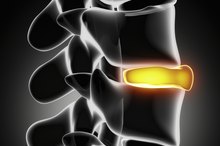Osteopath Vs. Chiropractor
The differences between chiropractors and osteopathic physicians seem subtle when the philosophies are compared. The differences become obvious when considering the scope of practice and the educational requirements of the two. Both subscribe to the whole body concept of treatment. While chiropractors believe nerve interference causes disease, osteopathic physicians believe lack of blood flow leads to disease.
Osteopathic Medicine
Osteopathic medicine was founded in the 1860s by Andrew Taylor Still. Andrew Still was a medical doctor and surgeon who served in the Union Army. In 1864 Still lost his three children to spinal meningitis. He became disenchanted with orthodox medicine and began studying the relationship between the musculoskeletal system and disease. According to the American Association of Colleges of Osteopathic Medicine, "Osteopathic medicine is a distinctive form of medical care founded on the philosophy that all body systems are interrelated and dependent upon one another for good health."
- Osteopathic medicine was founded in the 1860s by Andrew Taylor Still.
Chiropractic
List of All Types of Physicians
Learn More
Chiropractic care was founded in 1895 by Daniel David Palmer. According to the American Chiropractic Association, the chiropractor is devoted to paying careful attention to the biomechanics, function and structure of the spine, its effects on the musculoskeletal and neurological systems and the role played by the proper function of these systems in the preservation and restoration of health. Chiropractors believe the body will heal itself if the structure and function are corrected.
Osteopathic Medicine Scope of Practice
Osteopathic physicians have gained the rights to perform surgery and prescribe medicine. They practice more in line with medical doctors. Osteopathic physicians still believe in the philosophy of treating the whole person rather than treating only the symptoms. However, the number of osteopathic physicians that perform manipulation has dwindled. Osteopathic physicians are required to train in hospitals in similar disciplines required of medical doctors, including residencies. They are also able to specialize in different types of medical practice.
- Osteopathic physicians have gained the rights to perform surgery and prescribe medicine.
Chiropractic Scope of Practice
Doctors That Specialize in Fitness & Nutrition
Learn More
Chiropractors limit their practice to headaches, low back pain, sciatica, joint problems and related issues. They treat osteoarthritis, spinal disk conditions, carpal tunnel syndrome and tendon and ligament issues such as sprains and strains. Chiropractors do not administer prescription medication, although they do recommend vitamins and herbal remedies. They do not perform invasive treatments. The educational requirements of chiropractors are not as involved as those of osteopathic physicians, as chiropractors do not perform surgery. The main treatment modalities used by a chiropractor are spinal manipulation, physical therapy and nutrition. The chiropractic philosophy is that structure and function are dependent on one another. If the structure is corrected, the function will correct itself, allowing the body to heal.
- Chiropractors limit their practice to headaches, low back pain, sciatica, joint problems and related issues.
Chiropractor or Osteopathic Physician
When deciding which health provider is best for you, many things should be considered. The nature of the health issue, the severity and your personal preference should play a role in making a decision. Problems of the spine such as general back pain, muscle strains and sprains, sciatica and headaches may be best treated more conservatively by a chiropractor. Illnesses such as bacterial infections, viral infections and systemic diseases that require medications and more aggressive treatment are more suited to treatment by an osteopathic physician.
- When deciding which health provider is best for you, many things should be considered.
- The nature of the health issue, the severity and your personal preference should play a role in making a decision.
Related Articles
References
- American Association of Colleges of Osteopathic Medicine: The History of Osteopathic Medicine
- Davis GE, Gayer GG. Comparison of Basic Science Knowledge Between DO and MD Students. J Am Osteopath Assoc. 2017;117(2):114-123. doi:10.7556/jaoa.2017.022
- Licciardone JC. A comparison of patient visits to osteopathic and allopathic general and family medicine physicians: results from the National Ambulatory Medical Care Survey, 2003-2004. Osteopath Med Prim Care. 2007;1:2. doi:10.1186/1750-4732-1-2
- Schwerla F, Kaiser AK, Gietz R, Kastner R. Osteopathic treatment of patients with long-term sequelae of whiplash injury: effect on neck pain disability and quality of life. J Altern Complement Med. 2013;19(6):543-9. doi:10.1089/acm.2012.0354
- Fleming SA, Gutknecht NC. Naturopathy and the primary care practice. Prim Care. 2010;37(1):119-36. doi:10.1016/j.pop.2009.09.002
Writer Bio
Mark Little began his professional writing career in 2009 with his work appearing on various websites. He emphasizes alternative approaches to health-related issues. He is certified as a sports nutritionist by the International Fitness Association. Little graduated from Texas Chiropractic College with a Doctor of Chiropractic degree.









